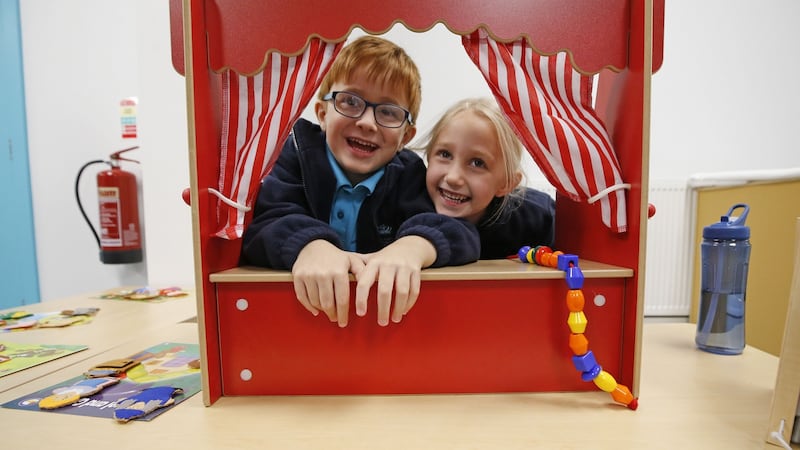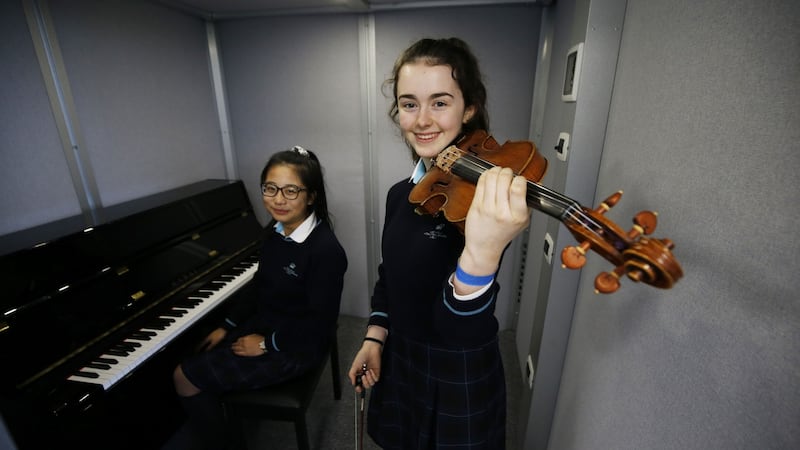It's 7.45am and traffic is crawling. You pass the sprawling new European headquarters for Microsoft and the gleaming offices of global firms such as Merrill Lynch, Vodafone, Bank of America and Salesforce.
At the far end of South County Business Park, beyond a security barrier, children emerge from private buses which serve suburbs such as Ballsbridge, Sandymount and Blackrock.
The students, dressed in navy-blue uniforms, look like they are arriving at the headquarters of a large multinational company.
But this is the setting for the country’s newest and most expensive school – and a potentially disruptive force in Irish education.
Nord Anglia International School Dublin, which opened its doors a fortnight ago, charges up to €24,000 per annum for day pupils.
The school is mainly targeting the children of mobile international executives, though it also hopes to attract Irish families seeking a “premium” education for their children.
It is educating children ranging from three to 15 years, though it will extend to 16- to 18-year-olds from September 2019 onwards.
We're different. We see ourselves as a rich and innovative addition to the system here ... We're not here to upset any apple-carts
What makes it stand out from any other school in the State is that it is offers the International Baccalaureate (IB) programme, from pre-school to secondary level.
The qualification is recognised world-wide and culminates in a two-year diploma, equivalent to the Leaving Cert.
It’s a programme which policy-makers, who are currently reviewing the Leaving Cert, are watching closely as a potential model for our education reforms.
The school is operated by a Hong Kong-based firm which runs international schools across the globe, and backed by businessman Barry O'Callaghan's firm Rise Global.
It has spent millions of euro converting what used to be Microsoft’s old headquarters into a school with specialist arts and Steam (science, technology, engineering, art and maths) facilities.
Inside, many classrooms resemble the kind of gleaming white futuristic visions you see in science fiction movies.
There are pods of tables, aimed at fostering group conversation, giant video screens, state-of-the-art 3D printers, recording studios and high-end metal and woodwork equipment.
Some classes have one-way mirrors – like you see on crime dramas – to allow for observation on classes.
Paul Crute, the school's principal, was hired from the Royal School Armagh, one of the North's most prestigious fee-paying schools.
“We know we’re disruptive,” he says. “We’re different. We see ourselves as a rich and innovative addition to the system here... We’re not here to upset any apple-carts, but we think there will be a demand for this in a capital city of Dublin’s stature.”
While detractors have long criticised the Leaving Cert as an outdated approach which encourages rote-learning and regurgitation, some educators see the IB as the world’s gold-standard curriculum.

It places a heavy emphasis on so-called higher order skills such as critical and independent thinking, along with an emphasis on how to inquire with care and logic.
“I went to an old-fashioned grammar school where we were pails to be filled,” he says.
“[Here] we’re about teaching in the Socractic-style; it’s about conversation, teasing out issues and synthesis, those higher order skills.
Most of the children enrolled so far, he says, are from families who are “seasoned internationalists” and are familiar with the IB.
Smaller numbers are from local families who want to give their children a different educational experience – though he feels this will grow.
The motto we've adopted for our school is: 'Come to the edge'. It's about encouraging risk-taking but also caring for the student
"In Ireland, we are cautious... if someone's buying a horse they want to see its teeth and its undercarriage... we think the local market may be a bit cautious, but when the word gets out, they will catch on," he says.
He says the school is determined that its first batch of graduates from the IB diploma – the equivalent of the Leaving Cert – will “smash it out of the park” in terms of performance and progression to top universities.
Crute previously taught in international schools and Gordonstoun School in Scotland, whose past pupils include Prince Philip and – for an unhappy time – Prince Charles.
That school’s physical challenges – early morning runs, cold showers, short trousers all-year – were at the heart of building character.

Crute has a lot of time for the school's founder, Kurt Hahn, a progressive educator who gave Gordonstoun the motto: "There is more in you".
He has adopted the ideas of “planned discomfort” for Nord Anglia (though, to the relief of students, icy showers or short trousers are not mandatory).
"The motto we've adopted for our school is: 'Come to the edge', from the poem by Christopher Logue. It's about encouraging risk-taking - but also caring for the student."
Students, he says, learn far more about themselves when they are out of their comfort zone, which helps develop traits such as resilience and problem-solving.
That can range from taking a challenging class or getting involved in “service learning”, such as volunteering with charities locally or internationally.
He says teachers play a crucial role, which is why the school has sourced what he describes as “impressively and exceptionally rounded internationalists”.
Some are Irish teachers who have worked abroad in international schools. while others international teachers who were keen to move here.
While the school has declined to say how much they are paid, they are understood to be on higher salaries than standard teachers in the public system.
The IB curriculum is also firmly global. There are no specific sections, for example, on Irish history, though teachers have the freedom to explore key events – such as the Famine – though so-called learning units.
While the school offers Irish, it isn’t on the IB curriculum yet – though Crute says they are in discussions about changing this soon,
Neither is there English literature. Instead, through a world literature curriculum, second-level students are as likely to learn Gabriel García Márquez as Yeats.
But what do students think? Some of students The Irish Times spoke to were positive about the ethos and approach.
“We feel like we’re a family, they are small classes and we’ve all bonded pretty quickly” says one 14-year-old student in grade nine.
Given average class sizes of about 10 children so far and the fact that it employs about 30 teachers, it is likely to have in excess of 100 students
Another Irish student, who was in an Irish secondary school until recently, says she likes the international focus.
“It feels much more global. It’s definitely more challenging. It’s a big shift in mindset.”
For Irish parents thinking about sending their children, however, there are still major barriers.

Nord Anglia's fees are about three times more expensive than day pupil fees charged by even the most expensive Dublin private schools such as St Columba's College (€8,000 per year), Sutton Park School (€7,900 per year) and Alexandra College (€7,240 per year).
Another obstacle is that the Leaving Cert is regarded as more generous in attracting CAO points. That is because some key sections of the IB are not formally recognised by Irish universities.
It’s difficult to say for sure how popular the school is so far. Nord Anglia will not comment on how many children are enrolled. However, given average class sizes of about 10 children so far and the fact that it employs about 30 teachers, it is likely to have in excess of 100 students.
Crute points out that the high fees are because none of its teachers are paid out of the public purse, unlike private schools whose teachers – for the most part – are paid for by the State.
Nord Anglia is also in discussion with Irish universities to ensure the IB attracts the kind of CAO points it merits.
Despite the potential barriers, he feels that, in time, the distinctive pedagogy and approach of the IB will attract globally-minded Irish parents.
“It’s an innovation that people aren’t used to, so it will take time,” says Crute. “It requires an open-minded parent and one that’s prepared to take a paradigm shift to buy into.”
Ireland’s most expensive schools:
Nord Anglia, Leopardstown, Dublin: €15,000-€24,000
St Columba’s College, Dublin: €8,000
Sutton Park School, Dublin 13: €7,900
Alexandra College, Dublin: €7,240
St Gerard's, Bray, Co Wicklow: €7,150
Sandford Park School, Dublin 6: €7,150
Rathdown School, Co Dublin: €6,950
Blackrock College, Co Dublin: €6,900
Castleknock College, Dublin 15; €6,116
Gonzaga, Dublin 6: €6,015
Day pupil fees for 2017/18. Excludes boarding schools.










